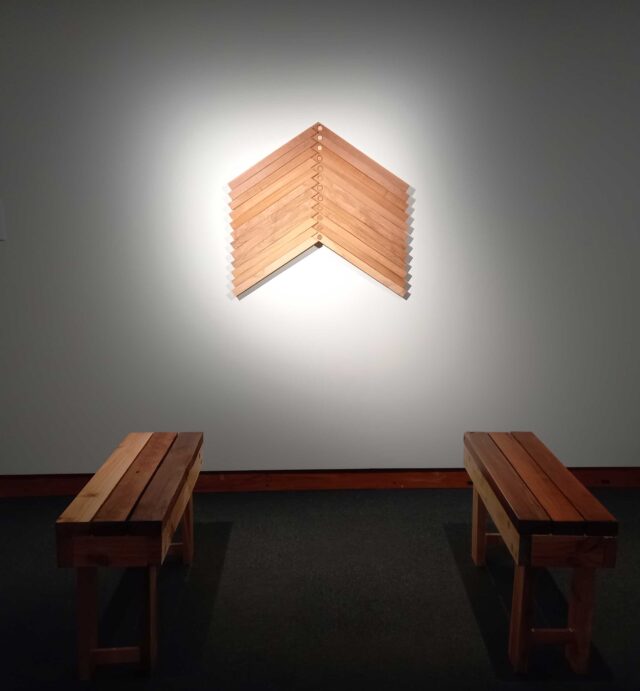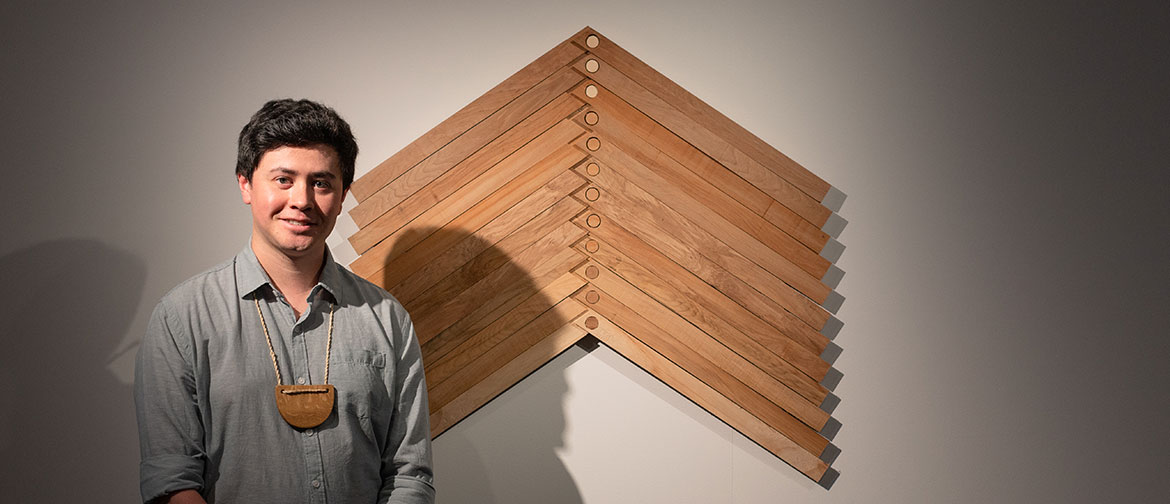Your art is about the intersection of being in motion and being at rest; how did you come to this as a concept to express in your work?
My kaupapa, titled Tūru Noho Ora – Tūrangahakoa, is me looking at the paepae, the front of the marae ātea, as a zone of demarcation and negotiation. It’s a space that navigates manuhiri and ahikā, and the responsibilities of support and care, manaakitanga, to visitors in the space.
These two benches have come from my consideration of what a seat is and what, as a functional object, it gives to someone. In thinking about the relationship between ahikā – those that are looking after the home – and manuhiri, the visitors, at the front before being welcomed there is often a seat, as a sign that we’re welcoming those who are moving onto the marae and into the wharenui. I found that an interesting object to consider and investigate.
Are the benches designed to be sat on as part of the exhibition?
Absolutely. In thinking about an art space and exhibition in line with my kaupapa, and thinking about visitors, I saw chairs and seating as a way to show that manaakitanga, so yes, these are intended as functional objects for someone to sit on, should they be seeking rest or just a chance to ponder while they’re looking around the exhibition.
Is there anything you’d like people to think about particularly while they’re seated?
One key part of these benches and other seating that I’ve made throughout the year was to build them in pairs. This is to talk about the tuakana/taina relationship – older and younger siblings, but also mentor and mentee. Throughout my walk within art and specifically Māori art I’ve had great mentors in my life to guide me along the way, and this making is a response to my feelings toward things that have guided me in the whakapapa of Māori art but also my own whakapapa and tīpuna.
What’s the role of the wall-mounted piece?
The work on the wall is titled Turangahakoa. I built this thinking about a tohu, a sign, that embodies a signal of thanks and my own learning along the way. The work is made of twelve ascending parts, and this is to connect to the pūrākau of Tane, “me ngā kete wānanga” – Tane’s adventure to obtain the three kete of knowledge. This pūrākau has been a foundation for my kaupapa, in thinking about what it is to gain knowledge. The title describes a place of joy – in thinking about this as an installation together, with a place to seat and rest and find support, with this a tohu of looking ahead to where you’re going. This kaupapa, Tu Noho Ora, is my mihi to my taha Māori.
Here in the centre I reveal, through the use of the wood-joining technique called half-lap, this zagged line. This is me connecting to Te Ara Manawa, which is a part of kōwhaiwhai, the centreline that refers to the hearbeat. For me this is the tohu where I think about my own life, and my journey towards attaining knowledge, not only of Māori art but also my own whakapapa. Alongside it I’ve connected four sets of three circles that interchange with the woods that I’ve used, which are tōtara, matai, rimu and pine. This is my reference to ngā kete wānanga, the three baskets of knowledge, and the exchange between the wood is thinking about taonga tuku iho, the knowledges that are passed down.
Did you have background experience in woodworking that you were able to draw on for this work?
No, but it’s been a project that I’ve wanted to go into. Toioho ki Āpiti was a special and welcoming place to bring my project and my kaupapa to, and they’ve really embraced my idea by going ahead and letting me make it this year.
Where there any big technical challenges you had to overcome?
Throughout the year, a lot of my introduction and training in the wood workshop, with regard to the different saws and planers and sanders – it’s my first time using them! For me it was an opportunity to upskill while also working towards my kaupapa making.
Is it a medium you’d like to continue working in?
It is. There are two artists, Manaaki Wilson and American artist Joseph Kosuth, whose work I’m a big fan of. I love considering how chairs can be a form of art, and both of those artists give me an introduction to that, and inspire ways to negotiate the form of a chair.
 Brook Konia, Tūru Noho Ora – Tūrangahakoa, 2022
Brook Konia, Tūru Noho Ora – Tūrangahakoa, 2022




